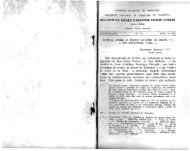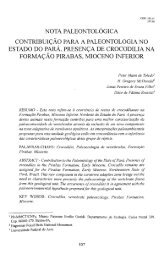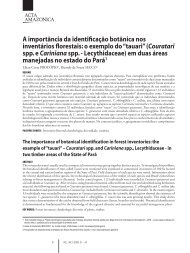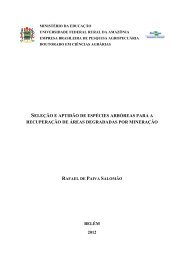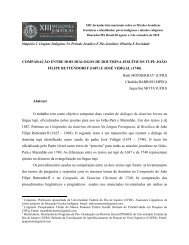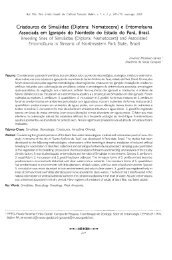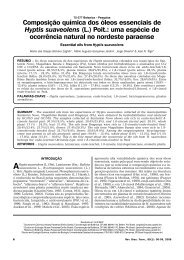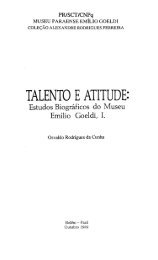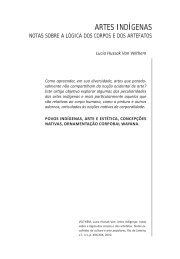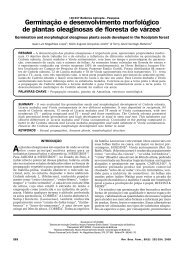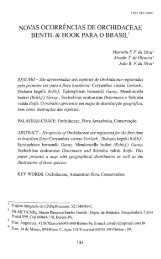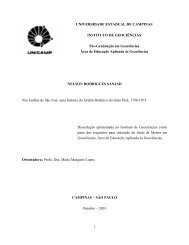FROM THE LOWER JAPURA RIVER, AMAZONAS STATE, BRAZIL
FROM THE LOWER JAPURA RIVER, AMAZONAS STATE, BRAZIL
FROM THE LOWER JAPURA RIVER, AMAZONAS STATE, BRAZIL
You also want an ePaper? Increase the reach of your titles
YUMPU automatically turns print PDFs into web optimized ePapers that Google loves.
BoL Mus. Para. Emllio Goeldi, sér. ZooL, 7(1), /99/Biology - This species builds arboreal or epigeal nests, frequentIy at the base oftrees. The nests are dark, similar to those built by Termes spp. This species wasfound only in the "terra firme" forestOrthognathotermes humilis, sp.n.(Figures 28-30)Material - MPEG 2825 (holotype soldier, paratypes soldiers and workers),MZSP 9249 (paratypes soldiers workers).Imago - Unknown.Soldier - Head elongated with sides straight, converging toward front Top ofhead in profile with a prominence between antennal lobes and a depressionbehind the prominence. Labrum three-Iobed. Head with scattered hairs and fewshort bristIes. Labrum with 12 bristIes. Pronotum covered with hairs and withbristIes on margins. Tergites and sternites with numerous hairs on surface and afew short bristIes on posterior margin. Tibiae with spines on the distai innermargin. Tibial spurs 3:2:2. Antennae with 15 segments, first longer than fifth,fourth and fifth ofequallenght, fourth longer than second, third the smallest one.Head capsule orange yellow to orange. Antennae orange. Pronotum and legsyellow. Abdomen yellowish, transparentMeasurements (in millimeters) of five soldiers: length of head to lateralbase of mandible 3.04-3.26; maximum width of head 1.96-2.04; height of headexcluding postmentum 1.43-1.48; maximum length of mandible 2.65-2.70;maximum width ofpostmentum 0.57-0.61; maximum width ofpronotum 1.221.26; length of hind tibia 1.52-1.57.Worker - Head rounded, abdomen voluminous. Antennae with 14 segments.Head with scattered long bristIes. Labrum with 10 bristIes. Chaetotaxy oflegs andabdomen similar to that of soldier. Tibial spurs 2:2:2. Head, pronotum and legsyellowish white; abdomen yellowish, transparent. Mandib1es as in Fig. 30.Enteric valve armature well sclerotized, 3 swellings of 1 st order a1ternating with 3swellings of2nd order. Swellings of 1 st order with bulbous, finger-like processesextending toward the lumen of the valve, covered with dense short spines.Swellings of 2nd order with smaller spines, only in their basal part (Fig. 29).Comparisons - o. aduncus is smaller, has the head with sides parallel, and thelabrum weakly three-Iobed. O. giberorum has a deep furrow down the back ofthehead. O brevipilosus has dense short hairs on head O. macrocephalus lacks theprominence between antennallobes. O. orthognathus is larger and the sides ofthe head are parallel. O. wheeleri is smaller, and the head is proportionallyshorter.Biology- The single colony was collected in soil on the roots ofa fallen tree and isprobably subterranean.Planicapritermes planiceps (Emerson) 1925Material- MPEG 2838, 2862, 2898.Biology - This species has specialized habits, living in and under the bark ofdeadwood. Soldiers and workers of P. planiceps are dorso-ventrally flattened as anadaptation to this particular habit.200Termites from the Japurá RiverSpinitermes longiceps, sp.n.(Figures 20-24)Material- MPEG 2835 (holotype soldier and paratypes soldiers, a1ates andworkers), MZSP 9248 (paratypes soldiers, alates and workers).Imago - Head capsule rounded. Eyes large, with small distance to lower marginof head. Ocellus close to eyes. Fontanelle small, elongated. Labrum short,rounded. Mandibles as in F ig. 23. Antennae with 15 segments, frrst longer thanfourth, fifth equal fourth, fifth longer than second, third the smallest one.Pronotum trapezium-shaped with sides convex, a littIe narrower than head. Mesoand metanotum with a deep incision on posterior margin Head densely coveredwith short hairs and a few bristles. Labrum with numerous bristIes. Pronotum,mesonotum and metanotum with numerous hairs. Legs with hairs and bristIes.Tibiae with spines on inner margin. Tibial spurs 3:3:2, but third spur only a littlelarger than spines. Tergites and sternites with many hairs on surface. Sterniteswith a row of bristIes on' posterior margin. Head capsule brown. Fontanellehyaline. Clypeus pale brown. Pronotum a littIe paler than head, with a T-shapedlight mark near anterior margin; Legs yelIow-brown. Tergites pale brown.Sternites a littIe paler than tergites. Wings pale brown.Measurements (in milIimeters) offive alates: lenghtofhead to lateral baseofmandibles 0.73-0.77; maximum width ofhead with eyes 0.95-1.00; height ofhead excluding postmentum 0.48-0.50; maximum diameter of eye 0.39;maximum length ofpronotum 0.55-0.57; maximum width ofpronotum 0.86-0.91:length of hind tibia 1.25-1.30.Soldier - Head capsule elongate; sides straight and almost parallel. Frontalprojection ( or"cap") small, narrow at tip; lateral points small. Labrum wide withtwo lateral, hyaline points. Antennae with 14 segments, first longer than second,fifth equal second, fifth longer than third, second the smallest one. Head capsulewith few scattered bristIes. Frontal projection with many bristIes directedforward. Labrum with numerous bristIes. Pronotum with bristles on margins andhairs on surface. Meso and metanotum with bristles on posterior margin and hairson surface. Legs with median and long bristIes. Tibiae with spines on innermargin Tibial spurs 3:3:2. Tergites and sternites with numerous hairs on surface.Sternites with a row of bristIes on posterior margin. Head ferruginous orange.Pronotum and legs yellow. Abdomen yellowish, transparent.Measurements (in millimeters) of five soldiers: length of head to lateralbase ofmandible 1.86-2.00; maximum width ofhead 1.11-1.14; height ofheadexcluding postmentum 0.91-0.98; maximum length of mandible 1.32-1.39;maximum width ofpostrnentum 0.41-0.45; maximum width ofpronotum 0.660.68; length of hind tibia 0.82-0.89.Worker- Mandibles as in Figure 22. Enteric valve armature with scattered smallspines and a few large ones. (Figure 24). .Compan'sons - The soldiers of alI other species known of this genus have thehead proportionally shorter with a larger projection on topo The alate of S.trispinosus is darker, has eyes, ocelli and fontanelle proportionally smaller, andthe pronotum proportionally wider. The alate of S. brevicornutus has smallereyes and wider pronotum. Both a1ates and soldiers ofthe other species have tibialspurs 2:3:2.201



